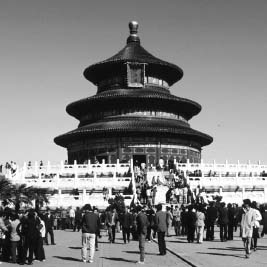Confucianism, the Literati, and Chinese Imperial TraditionsSigns and Symbols |
What would I see if I visited one of the surviving CIT sacred places? |
Beijing’s Temple of Heaven (Tian Tan) is perhaps the best example of such a site. The Chinese long ago mastered the art of creating monumental public spaces, as the Temple demonstrates admirably. From its southern gate to the northern wall the complex stretches half a mile along its main ceremonial axis. The compound covers an area larger than that of the Forbidden City about two miles to the north, and it is some four times the area of its original northern Yin counterpart, the Temple of Earth. Whereas the temple compounds devoted to the feminine Earth and moon are square in plan, those of Heaven and sun are round-shouldered at their rear perimeters and squared off (like a large U-shape) at the opposite ends where their entry gates are located. Confucian-Literati concepts of hierarchy in authority structures and in family lineage are based on a patriarchal model, and are evident in these as well as most other traditional Chinese structures.
As you enter the main southern gate of the Temple of Heaven and walk north, you come first to the Altar of Heaven. It is a square enclosure surrounding a circular terrace of three concentric tiers— round Heaven surrounded by square Earth, as in the overall plan of the site. The Altar’s symbolism includes its use of nine courses of pavement on each of its three levels—nine being the maximum level of Yang energy. The posts in its surrounding railings, numbered in multiples of nine on each level, total three hundred and sixty, recalling the totality of degrees in Heaven’s circle. The circular Hall of Harvest Prayer at the northern perimeter of the compound also stands within a square enclosure. Symbolizing the firmament, the triple-roofed structure stands on two concentric circles of twelve columns apiece, reminders of the months of the year and the Chinese reckoning of twelve units of time per day. Four larger central columns inside the circle symbolize the seasons. Like the Altar, the Hall sits atop a triple-tiered circular platform. Geometric and numerical symbolism abound.

The Temple of Heaven, Beijing, is also set on a circular, three-tiered platform.
